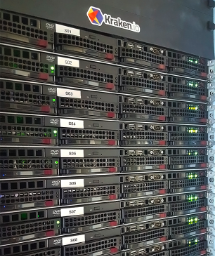Author Archives: Todd Hoff
Author Archives: Todd Hoff
Hey, it's HighScalability time:

If Google were created from scratch today, much of it would be learned, not coded. Around 10% of Google's 25,000 developers are proficient in ML; it should be 100% -- Jeff Dean
Like the weather, everybody complains about programming, but nobody does anything about it. That’s changing and like an unexpected storm the change comes from an unexpected direction: Machine Learning / Deep Learning.
I know, you are tired of hearing about Deep Learning. Who isn’t by now? But programming has been stuck in a rut for a very long time and it's time we do something about it.
Lots of silly little programming wars continue to be fought that decide nothing. Functions vs objects; this language vs that language; this public cloud vs that public cloud vs this private cloud vs that ‘fill in the blank’; REST vs unrest; this byte level encoding vs some different one; this framework vs that framework; this methodology vs that methodology; bare metal vs containers vs VMs vs unikernels; monoliths vs microservices vs nanoservices; eventually consistent vs transactional; mutable vs immutable; DevOps vs NoOps vs SysOps; scale-up vs scale-out; centralized vs decentralized; single threaded vs massively parallel; sync vs async. And so Continue reading

IT Security Engineering. At Gusto we are on a mission to create a world where work empowers a better life. As Gusto's IT Security Engineer you'll shape the future of IT security and compliance. We're looking for a strong IT technical lead to manage security audits and write and implement controls. You'll also focus on our employee, network, and endpoint posture. As Gusto's first IT Security Engineer, you will be able to build the security organization with direct impact to protecting PII and ePHI. Read more and apply here.
Awake Networks is an early stage network security and analytics startup that processes, analyzes, and stores billions of events at network speed. We help security teams respond to intrusions with super-human efficiency and provide macroscopic and microscopic insight into the networks they defend. We're looking for folks that are excited about building systems that handle scale in a constrained environment. We have many open-ended problems to solve around stream-processing, distributed systems, machine learning, query processing, data modeling, and much more! Please check out our jobs page to learn more.
Hey, it's HighScalability time:


Fewer companies know how to build world spanning distributed services than there are countries with nuclear weapons. Facebook is one of those companies and Facebook Live, Facebook’s new live video streaming product, is one one of those services.
Facebook CEO Mark Zuckerberg:
The big decision we made was to shift a lot of our video efforts to focus on Live, because it is this emerging new format; not the kind of videos that have been online for the past five or ten years...We’re entering this new golden age of video. I wouldn’t be surprised if you fast-forward five years and most of the content that people see on Facebook and are sharing on a day-to-day basis is video.
If you are in the advertising business what could better than a supply of advertising ready content that is never ending, always expanding, and freely generated? It’s the same economics Google exploited when it started slapping ads on an exponentially growing web.
An example of Facebook’s streaming prowess is a 45 minute video of two people exploding a watermelon with rubber bands. It reached a peak of over 800,000 simultaneous viewers who also racked up over 300,000 comments. That’s Continue reading
Hey, it's HighScalability time:

There’s a war between two visions of how the ubiquitous AI assisted future will be rendered: on the cloud or on the device. And as with any great drama it helps the story along if we have two archetypal antagonists. On the cloud side we have Google. On the device side we have Apple. Who will win? Both? Neither? Or do we all win?
If you would have asked me a week ago I would have said the cloud would win. Definitely. If you read an article like Jeff Dean On Large-Scale Deep Learning At Google you can’t help but be amazed at what Google is accomplishing. Impressive. Wide ranging. Smart. Systematic. Dominant.
Apple has been largely absent from the trend of sprinkling deep learning fairy dust on their products. This should not be all that surprising. Apple moves at their own pace. Apple doesn’t reach for early adopters, they release a technology when it’s a win for the mass consumer market.
There’s an idea because Apple is so secretive they might have hidden away vast deep learning chops we don’t even know about yet. We, of course, have no way of knowing.
What may prove more true is that Continue reading
Hey, it's HighScalability time:


This article will touch upon how Kraken.io built and scaled an image optimization platform which serves millions of requests per day, with the goal of maintaining high performance at all times while keeping costs as low as possible. We present our infrastructure as it is in its current state at the time of writing, and touch upon some of the interesting things we learned in order to get it here.
You want to start saving money on your CDN bills and generally speed up your websites by pushing less bytes over the wire to your user’s browser. Chances are that over 60% of your traffic are images alone.
Using ImageMagick (you did read ImageTragick, right?) you can slash down the quality of a JPEG file with a simple command:
$ convert -quality 70 original.jpg optimized.jpg
$ ls -la
-rw-r--r-- 1 matylla staff 5897 May 16 14:24 original.jpg
-rw-r--r-- 1 matylla staff 2995 May 16 14:25 optimized.jpg
Congratulations. You’ve just brought down the size of that JPEG by ~50% by butchering it’s quality. The image now looks like Minecraft. It can’t look like that - it sells your products Continue reading

IT Security Engineering. At Gusto we are on a mission to create a world where work empowers a better life. As Gusto's IT Security Engineer you'll shape the future of IT security and compliance. We're looking for a strong IT technical lead to manage security audits and write and implement controls. You'll also focus on our employee, network, and endpoint posture. As Gusto's first IT Security Engineer, you will be able to build the security organization with direct impact to protecting PII and ePHI. Read more and apply here.
Awake Networks is an early stage network security and analytics startup that processes, analyzes, and stores billions of events at network speed. We help security teams respond to intrusions with super-human efficiency and provide macroscopic and microscopic insight into the networks they defend. We're looking for folks that are excited about applying modern bleeding edge techniques to build systems that handle scale in a constrained environment. We have many open-ended problems to solve around stream-processing, distributed systems, machine learning, query processing, data modeling, and much more! Please check out our jobs page to learn more.
Site Reliability Engineer Manager. We at Spotify are looking for an engineering leader (Chapter Continue reading

Site Reliability Engineer Manager. We at Spotify are looking for an engineering leader (Chapter Lead) to manage the NYC part of the Site Reliability Engineering team. This team works with the infrastructure that powers the music service used by millions of users, built by hundreds of engineers. We create tools, develop infrastructure, and teach good practices to help Spotify engineers move faster. As a Chapter Lead your primary responsibility is to the people on your team: ensuring that the members are growing as engineers, doing valuable work, performing well, and generally having a great time at Spotify. Read more and apply here
Site Reliability Engineer. Spotify SREs design, code, and operate tools and systems to reduce the amount of time and effort necessary for our engineers to scale the world’s best music streaming product to 40 million users. We are strong believers in engineering teams taking operational responsibility for their products and work hard to support them in this. We work closely with engineers to advocate sensible, scalable, systems design and share responsibility with them in diagnosing, resolving, and preventing production issues. Read more and apply here
Backend Engineer. We at Spotify are looking for senior backend engineers Continue reading
This is a guest post from Vlad Mihalcea the author of the High-Performance Java Persistence book, on the notion of performance and scalability in enterprise systems.
An enterprise application needs to store and retrieve as much data and as fast as possible. In application performance management, the two most important metrics are response time and throughput.
The lower the response time, the more responsive an application becomes. Response time is, therefore, the measure of performance. Scaling is about maintaining low response times while increasing system load, so throughput is the measure of scalability.
Hey, it's HighScalability time:

Well, not exactly Fishin', but I'll be on a month long vacation starting today. I won't be posting (much) new content, so we'll all have a break. Disappointing, I know. Please use this time for quiet contemplation and other inappropriate activities. See you on down the road...

Hey, it's HighScalability time:


Where’s the magic? [Amazon] The databasing and streaming and syncing infrastructure we build on is pretty slick, but that’s not the secret. The management tools are nifty, too; but that’s not it either. It’s the tribal knowledge: How to build Cloud infrastructure that works in a fallible, messy, unstable world.
Tim Bray, Senior Principal Engineer at Amazon, in Cloud Eventing
Ben Thompson makes the case in Apple's Organizational Crossroads and in a recent episode of Exponent that Apple has a services problem. With the reaching of peak iPhone Apple naturally wants to turn to services as a way to expand revenues. The problem is Apple has a mixed history of delivering services at scale and Ben suggests that the strength of Apple, its functional organization, is a weakness when it comes to making services. The same skill set you need to create great devices is not the same skill set you need to create great services. He suggests: “Apple’s services need to be separated from the devices that are core to the company, and the managers of those services need to be held accountable via dollars and cents.”
If Apple has this problem they are not the only Continue reading


This is a guest repost from Baqend Tech on deploying and redeploying an Apache Storm cluster on top of Docker Swarm instead of deploying on VMs. It's an interesting topic because of the experience Wolfram Wingerath called it "a real joy", which is not a phrase you hear often in tech. Curious, I asked what made using containers such a good experience over using VMs? Here's his reply:
Being pretty new to Docker and Docker Swarm, I'm sure there are many good and bad sides I am not aware of, yet. From my point of view, however, the thing that makes deployment (and operation in general) on top of Docker way more fun than on VMs or even on bare metal is that Docker abstracts from heterogeneity and many issues. Once you have Docker running, you can start something like a MongoDB or a Redis server with a single-line statement. If you have a Docker Swarm cluster, you can do the same, but Docker takes care of distributing the thing you just started to some server in your cluster. Docker even takes care of downloading the correct image in case you don't have it on your machine right now. You also Continue reading
Hey, it's HighScalability time:

Today Twitter is creating and persisting 3,000 (200 GB) images per second. Even better, in 2015 Twitter was able to save $6 million due to improved media storage policies.
It was not always so. Twitter in 2012 was primarily text based. A Hogwarts without all the cool moving pictures hanging on the wall. It’s now 2016 and Twitter has moved into to a media rich future. Twitter has made the transition through the development of a new Media Platform capable of supporting photos with previews, multi-photos, gifs, vines, and inline video.
Henna Kermani, a Software Development Engineer at Twitter, tells the story of the Media Platform in an interesting talk she gave at Mobile @Scale London: 3,000 images per second. The talk focuses primarily on the image pipeline, but she says most of the details also apply to the other forms of media as well.
Some of the most interesting lessons from the talk:
Doing the simplest thing that can possibly work can really screw you. The simple method of uploading a tweet with an image as an all or nothing operation was a form of lock-in. It didn’t scale well, especially on poor networks, which made it Continue reading